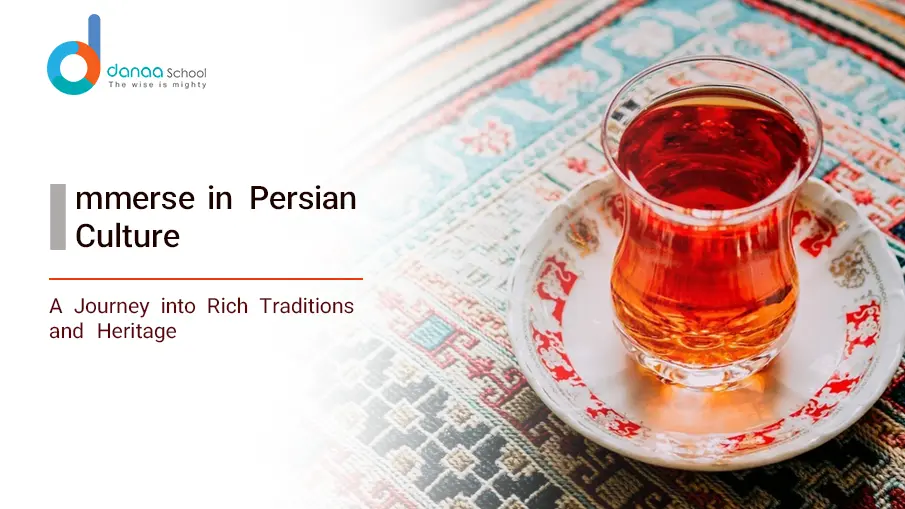Persian culture is a vibrant tapestry woven from centuries of history, art, and culinary tradition. From the majestic ruins of Persepolis to the intricate designs of Persian carpets and the tantalizing flavors of traditional dishes, Persian culture offers a feast for the senses and the soul. Are you interested in Persian Culture? In this blog, we’ll start a journey to discover the essence of Persian culture, exploring its historical landmarks, artistic achievements, and mouth-watering cuisine.
Historical Landmarks: Echoes of an Ancient Civilization
The Splendor of Persepolis
Persepolis, once the ceremonial capital of the Achaemenid Empire, stands as a testament to the grandeur of ancient Persia. Founded by Darius the Great in 518 BCE, this UNESCO World Heritage site features impressive terraces, colossal gateways, and intricately carved reliefs that narrate the empire’s glory.
– Apadana Palace: Known for its massive columns and audience hall, where dignitaries from various nations once paid tribute to the Persian king.
– Gate of All Nations: A monumental entrance adorned with colossal lamassu (winged bulls) symbolizing protection and power.
The Timeless Beauty of Pasargadae
Pasargadae, the capital of Cyrus the Great, offers a glimpse into the early architectural style of the Achaemenid dynasty. The Tomb of Cyrus stands as a simple yet powerful reminder of the empire’s founder, embodying both humility and grandeur.
– Tomb of Cyrus: A modest yet monumental tomb built from white limestone, reflecting Cyrus’s vision of leadership and unity.
– Royal Gardens: An early example of Persian garden design, emphasizing symmetry and tranquility.
The Enigmatic Towers of Silence
The Towers of Silence, or Dakhmas, used by Zoroastrians for sky burials, provide a unique insight into ancient Persian funerary practices. Perched on hillsides, these structures are stark yet evocative, reflecting the Zoroastrian belief in the purification of the dead by natural elements.
– Location: Typically found in desert areas around Yazd, these towers offer a hauntingly beautiful view of the surrounding landscape.
– Purpose: Used for exposing the dead to scavenging birds, thereby avoiding the pollution of earth or fire, which were considered sacred.
Persian Art: A Mosaic of Color and Craftsmanship
The Intricacies of Persian Carpets
Persian carpets are renowned for their intricate designs, vibrant colors, and unparalleled craftsmanship. Each region in Iran has its unique style, weaving techniques, and patterns, often inspired by nature, mythology, and daily life.
– Isfahan Carpets: Known for their detailed floral designs and high knot density, making them exquisite and luxurious.
– Kashan Carpets: Featuring elaborate medallion motifs and rich colors, these carpets are a hallmark of Persian artistry.
– Baluch Rugs: Often smaller and more geometric, reflecting the nomadic lifestyle and artistic traditions of the Baluch people.
The Elegance of Persian Miniature Paintings
Persian miniature paintings, with their delicate brushwork and vibrant palettes, depict epic tales, historical events, and poetic themes. These miniature masterpieces offer a window into Persian literature and storytelling.
– Themes: Often drawn from Persian epics like the Shahnameh, depicting heroes, battles, and love stories.
– Techniques: Fine lines, vivid colors, and detailed backgrounds, often incorporating gold and silver accents.
The Charm of Persian Calligraphy
Persian calligraphy is more than just writing; it’s an art form that blends beauty and meaning. Styles such as Nasta’liq and Shekasteh are celebrated for their fluidity, elegance, and harmonious proportions.
– Nasta’liq: Known as the “bride of calligraphy scripts,” it is used for poetry and literary works, characterized by its graceful curves.
– Shekasteh: A more dynamic and expressive style, often used in decorative arts and manuscripts.
Persian Cuisine: A Feast for the Senses
Persian cuisine is famed for its aromatic rice dishes, often garnished with herbs, fruits, and nuts. These dishes form the cornerstone of a Persian meal, offering both sustenance and delight.
– Chelo: Plain rice served with a crispy golden crust known as tahdig.
– Polo: Rice mixed with ingredients like saffron, barberries, and pistachios, creating dishes such as Zereshk Polo (barberry rice) and Shirin Polo (sweet rice).
The Savory Delight of Persian Kebabs
Kebabs are a staple of Persian cuisine, grilled to perfection and bursting with flavor. Whether it’s juicy lamb, marinated chicken, or succulent beef, Persian kebabs are a culinary delight.
– Kabab Koobideh: Ground meat skewers seasoned with onions and spices.
– Joojeh Kabab: Marinated chicken kebabs infused with saffron and lemon juice.
– Barg Kabab: Thinly sliced lamb or beef, marinated and grilled to tender perfection.
<H3> The Sweet Symphony of Persian Desserts
Persian desserts, with their delicate flavors and intricate textures, are a treat for those with a sweet tooth. From syrup-soaked pastries to fragrant puddings, these desserts reflect the artistry and hospitality of Persian culture.
– Baklava: Layers of flaky pastry filled with nuts and drizzled with sweet syrup.
– Faloodeh: A refreshing dessert made from thin vermicelli noodles mixed with rose water and served with lime juice or sour cherry syrup.
– Saffron Ice Cream (Bastani Sonnati): Creamy ice cream flavored with saffron, rose water, and pistachios.
Persian Festivals: Celebrating Heritage and Tradition
Nowruz: The Persian New Year
Nowruz, marking the arrival of spring, is a celebration of renewal, family, and nature. This ancient festival, dating back over 3,000 years, is observed with various customs and rituals.
– Haft-Seen Table: A traditional arrangement of seven symbolic items starting with the letter ‘S,’ each representing a different aspect of life and prosperity.
– Chaharshanbe Suri: A pre-Nowruz festival involving jumping over bonfires to symbolize purification and the warding off of evil.
<H3> Yalda Night: The Longest Night of the Year
Yalda Night, celebrating the winter solstice is a time for family gatherings, storytelling, and feasting on fruits and nuts. This ancient festival symbolizes the triumph of light over darkness.
– Traditions: Reading poetry, especially the works of Hafez, and staying awake through the night to witness the dawn of longer days.
– Foods: Pomegranates, watermelon, and nuts are traditionally enjoyed, symbolizing the sun and life.
Mehregan: The Festival of Friendship and Love
Mehregan, an autumn festival dedicated to the goddess Mehr (Mithra), celebrates love, friendship, and harvest. It’s a time for communal feasting, giving thanks, and sharing joy.
– Rituals: Setting up altars with fruits, flowers, and candles, and offering prayers for health and prosperity.
– Celebrations: Music, dancing, and sharing of traditional dishes with friends and family.
FAQs
1. What is the significance of Nowruz in Persian culture?
Nowruz, the Persian New Year, marks the beginning of spring and symbolizes renewal and rejuvenation. It’s celebrated with various customs, including the setting up of a Haft-Seen table and participating in Chaharshanbe Suri.
2. How do Persian carpets differ from each other?
Persian carpets vary by region, with each area having distinct styles, patterns, and techniques. For example, Isfahan carpets are known for their intricate floral designs, while Kashan carpets often feature medallion motifs.
3. What are some must-try dishes in Persian cuisine?
Must-try dishes include Chelo (plain rice with tahdig), Kabab Koobideh (ground meat skewers), and Faloodeh (a dessert with vermicelli noodles and rose water).
4. What role does calligraphy play in Persian art?
Calligraphy is a revered art form in Persian culture, blending aesthetics with meaning. Styles like Nasta’liq and Shekasteh are used in various contexts, from poetry to decorative arts.
5. What makes Persian miniature paintings unique?
Persian miniature paintings are distinguished by their delicate brushwork, vivid colors, and intricate details, often depicting epic tales and poetic themes.
Conclusion
Persian culture, with its rich history, vibrant arts, and delectable cuisine, offers a captivating journey through time and tradition. From the awe-inspiring ruins of ancient Persia to the intricate patterns of its art and the tantalizing flavors of its dishes, Persian culture is a celebration of beauty, heritage, and hospitality.
Whether you’re exploring its historical landmarks, admiring its artistic achievements, or savoring its culinary delights, Persian culture invites you to embrace its essence and experience its timeless charm. Start learning Farsi and everything about Persian Culture.







